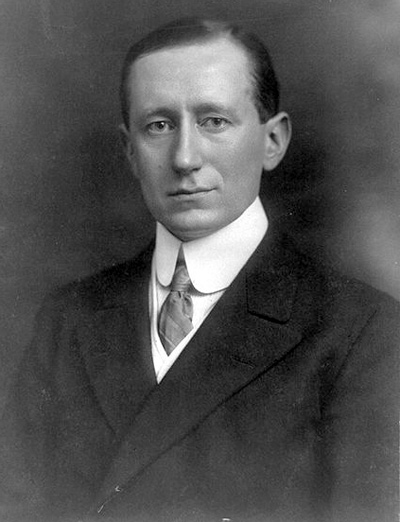
December 12 1901 Guglielmo Marconi makes first transatlantic radio transmission and reception.
Towards the end of the 1897th century Bolognese physicist Augusto Righi began to become interested in studying electromagnetic waves, a work that culminated with the publication of the volume ?? The Optics of Electrical Obscillations ?? (1897). Righi taught for more than thirty years at the University of Bologna where a young man of good family, and without a regular school career, could attend his lessons. That young man was William Marconi.
Marconi probably immediately understood the potential of the oscillator-receiver system and began self-taught conducting experiments in radio wave transmission, first at reduced distances and then ever greater. The first great success was achieved when radio signals crossed the Channel, exceeding the distance of 51 km. But how could we have done more?
It was well known that electromagnetic waves spread in a straight line, so it was permissible to overcome major obstacles and radio signals could be picked up. But how did we behave when Earth's warp was the obstacle to face? It was thought, rightly, that the signal travelling a not negligible distance would significantly diminish and that the receiver wouldn't catch any waves.
In 1901, Marconi organized one of the most expensive and important experiments of his life: he installed two radio antennas one in Cornwall (southwestern Great Britain) and one in St. John's, on Canadian island of Newfoundland. At 12 pm on 12 December Marconi receives the three dots of the letter S transmitted by the radio station in Cornwall. The signal is heard and travelled a distance of 3.000 km! It's the first transatlantic telegraphic transmission and it's the official birth of the radio; the Times talks about the experiment as ?? the greatest scientific achievement of the era ". How is this even possible? Is the theory wrong? Actually the answer was given a few years later, around 1924, and it's the discovery of the ionosphere. In fact, the ionosphere acts like a mirror and makes the wave ?? bounce
During the years of the experiments Marconi was unaware of the presence of the ionosphere and there are many questions about his experimental method. In fact Marconi received the Nobel Prize for Physics in 1909 ?? in recognition of his contribution to the development of wireless telegraphy ", but he never earned his degree in physics.
Let's conclude with Emilio's words:
?? This is why it doesn't always happen that those who know things see right and those who don't know them wrong. Not all the time! Because he was happy with the radio, he tried to repeat the same feat with radar and his ignorance betrayed him there ?? [anonymous]
In 1894, at just 20 years old, Guglielmo Marconi returned from a vacation in the Alps with an idea that would change the world. He locked himself in the attic of his family’s villa, Villa Griffone in Pontecchio, transforming it into a secret laboratory. For months, he tirelessly worked on wireless telegraphy experiments, supported by two young local assistants who, although not fully understanding his work, shared his enthusiasm.
The following summer, Marconi conducted his first major experiment. He placed a transmitter near the attic window and a receiver a few hundred meters away on a hill. The goal? To find out if radio waves could overcome obstacles such as hills.
Marconi gave precise instructions to his assistant, Mignani:
“Take the receiver to the other side of the hill, out of sight of the house. Listen for the signals. If you hear three clicks, fire a rifle shot.”
With his heart pounding, Marconi pressed the button three times. Then he waited, with his mother by his side, for the signal that would change history.
After what felt like an eternity, a rifle shot broke the silence of the valley. It had happened: the message had crossed the hill.
In that precise moment, wireless communication was born. With his genius and determination, Marconi had ushered in the era of wireless technology, laying the foundation for modern communications.
“Every great innovation begins with a dream and the courage to pursue it.”
